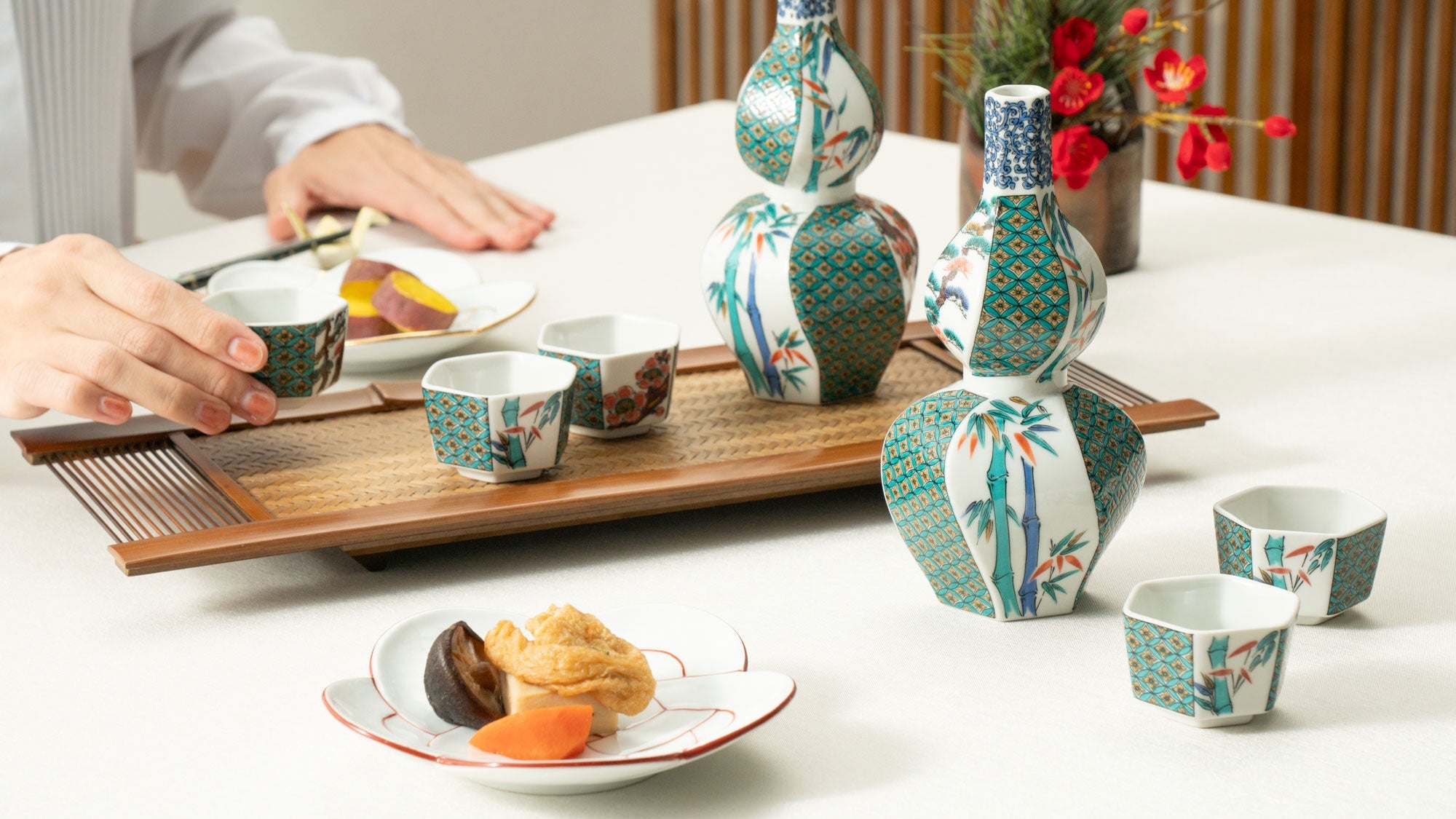
Welcome a Joyful New Year with Lucky Japanese Plants
Written by Team MUSUBI
The new year in Japan is a time rich with cherished traditions and symbols carrying deep meaning. Among these customs, symbolic plant motifs take center stage, each representing heartfelt wishes for the year ahead. Adding these symbols to festivities not only honors cultural heritage but also deepens the season’s warmth. This blog introduces five enduring botanical motifs along with items that beautifully showcase these designs, offering inspiration to enrich your celebrations.
table of contents
Matsu – Pine: A Timeless Wish for Longevity and Happiness

The resilient pine tree, matsu in Japanese, symbolizes strength and longevity, with evergreen leaves that stay vibrant year-round and lifespans stretching centuries. Traditionally, branches were displayed at doorways during New Year to invite good fortune—a custom that evolved into kadomatsu, auspicious decorations often placed at entryways toward year’s end. Kadomatsu are said to guide Toshigami-sama, the deity of happiness, bringing blessings into the home.

For those outside Japan, a small pine sprig in a vase or pine-inspired decor can add a timeless touch to New Year celebrations, rooted in wishes for lasting joy and well-being.
Take – Bamboo: Emblem of Straight and Fast Growth

Admired for its swift growth and sturdiness, take in Japan represents perseverance and the drive to reach new heights. Renowned for its ability to stand tall while bending with the strongest winds, bamboo embodies flexibility and the strength to endure life’s challenges. Paired with pine in kadomatsu, it brings a vibrant spirit that invites renewal as the New Year approaches.
For those familiar with kadomatsu, it’s interesting to note that bamboo takes on unique meanings depending on how it’s cut. The popular sogi cut, with its angled, “smiling” shape, is thought to bring good luck and is often chosen to warmly welcome guests. In contrast, the zundo cut, which has a straight, horizontal edge, emphasizes bamboo’s solid structure and conveys stability and prosperity—a reason why some banks and businesses still favor zundo kadomatsu today.


For a simple yet meaningful addition to your table setting, the bamboo-motif chopstick rest from Ihoshiro Kiln brings a refined nod to tradition. In Japan, chopstick rests are essential, and choosing one that reflects the season adds a thoughtful touch. The diagonal cut on this piece captures bamboo’s positive energy, making it perfect for New Year gatherings.
Ume – Plum: Blossoming Hope in Winter
Although ume, plum trees, bloom in early spring, later than the New Year, they remain a cherished symbol for the season. Their delicate petals and gentle fragrance emerge while winter’s chill lingers, embodying the spirit of new beginnings and favorable opportunities.

And together, pine, bamboo, and plum—known as shochikubai (松竹梅)—form an auspicious trio in Japanese culture, each symbolizing distinct qualities of longevity, growth, and magnanimity. Ume brings a softer beauty to complete the set. For those inspired by this trio, incorporating ume motifs into seasonal decor adds warmth and elegance to gatherings, celebrating the harmony of these traditional symbols.
To embrace the gentle charm of ume, the plum blossom knot small plate is a lovely addition to your table. This intricate knot motif symbolizes health, protection, and lasting bonds, making it perfect for New Year gatherings. Its unbreakable appearance represents a tight and lasting connection, bringing a sense of joy and unity to celebrations.
For those wishing to enjoy the full shochikubai experience, this special Kutani sake set is an excellent choice for the year’s first kanpai. Adorned with pine, bamboo, and plum motifs in vivid Kutani colors, the sake set captures the harmony of these symbols for the New Year.
Senryo – Chrismas Berry: A Bounty of Abundance

In Japan, the senryo plant—often referred to as Christmas berry for its bright, festive clusters of fruit—is celebrated for its association with wealth and abundance. The name senryo literally translates to “a thousand ryo,”" ryo being a historical Japanese currency unit used during the Edo period (1603 CE–1868 CE). The plant’s vibrant red berries are thought to attract fortune and flourishing opportunities, especially during New Year celebrations.
With its rich color and cheerful presence, senryo is a popular choice for winter displays and is also common as a garden or hedge plant outside Japanese homes. The contrast of clusters of red berries against deep green foliage celebrates the spirit of abundance and well-being as you ring in the New Year.
Nanten – Nandina: A Guardian for Good Fortune

In Japanese tradition, nanten, also known as nandina or “heavenly bamboo,” is cherished for its protective qualities and its association with overcoming adversity. “Nanten” literally translates to “turning difficulties around,” symbolizing the plant’s role in transforming challenges into opportunities for good fortune. Often planted near entrances, nandina’s vibrant red berries and delicate foliage are believed to ward off misfortune, adding both beauty and a sense of security to the home. Because of the plant’s auspicious symbolism, nandina leaves are also often used as a garnish in osechi ryori, the traditional New Year cuisine in Japan.
A graceful embodiment of this motif is the Aizu lacquerware soup bowl, decorated with a gold “spear flower” design, which adds an artful touch inspired by the spirit of nandina. With its glossy finish and ceremonial size, this bowl is perfect for serving ozoni, another traditional New Year’s menu item of grilled mochi in a dashi soup. Including nandina-inspired decor in your New Year celebration brings a blend of protection and optimism to welcome the year ahead.
May these symbols of matsu, take, ume, senryo, and nanten add a touch of tradition and heartfelt meaning to your New Year celebrations—each motif inviting joy and timeless wishes as we step into a new year.















Leave a comment
This site is protected by hCaptcha and the hCaptcha Privacy Policy and Terms of Service apply.